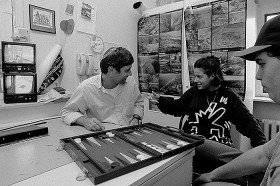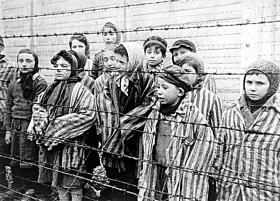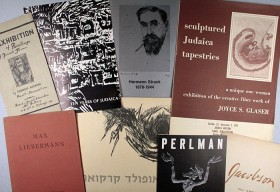Complementing our special exhibit, “Snip It! Stances on ritual circumcision”, our blogger team went looking for Jews and Muslims who could speak on the topic from a very personal perspective, whether for or against circumcising their sons. We called upon our networks of friends and acquaintances and received a range of responses in return. Some made us smile; others, like this one about David, gave us pause. It is retold to us by Shlomit Tulgan, our colleague in the education department who knows him from childhood:

Shlomit met David in the Jewish Culture Center in Berlin
On this photo you see a tutor of the Berlin Jewish Community’s youth center on Joachimstalerstr playing Backgammon with kids, Berlin 1992 © Photo: Michael Kerstgens, Jewish Museum Berlin
David was born to a secular Jewish mother and, at 22, chose to be circumcised in Berlin’s Jewish Hospital. His reason was to “get back to his roots and regain what his parents had denied him.” David was no “sad child,” remembers Shlomit, who met him most of all at the Berlin Jewish Community’s youth center on Joachimstalerstr. Seemingly every month he was in love with another Jewish girl, and he was popular among the opposite sex despite his nature to move swiftly from one to the next. The youth center was particularly supportive when the circumcision was performed. Recovering in a hospital bed, David’s Lebanese flatmate and friend → continue reading

Surviving children in the main concentration camp, Auschwitz. This still from documentary footage shot by Alexander Voronzow shows Tomasz Szwarz, Alicja Gruenbaum, Solomon Rozalin, Gita Sztrauss, Wiera Sadler, Marta Wiess, Boro Eksztein, Josef Rozenwaser, Rafael Szlezinger, Gabriel Nejman, Gugiel Appelbaum, Mark Berkowitz, Pesa Balter, Rut Muszkies, Miriam Friedman, and Miriam and Eva Mozes. Licensed for the public domain by the United States Holocaust Memorial Museum.
Seventy years ago to this day, the Soviet Army liberated the death camps Auschwitz I and II. Almost ten years ago, the anniversary was designated International Holocaust Remembrance Day. Although I’ve been reflecting on representations of the Holocaust in art, literature, and philosophy for many years, I remain irritatingly little affected by today’s date, January 27. In most European countries, official events will once again collectively recall that breach of civilization and commemorate those who were systematically murdered. So too will Germany. Here, the decision to officially commemorate the victims of the Holocaust on this day was reached in 1996—not least because → continue reading

Gray literature held by the library, Gross Family Collection © Jewish Museum Berlin, Photo: Lea Weik
The library of the Jewish Museum Berlin is growing day by day. Since early 2014, this has been particularly noticeable in the Jewish visual and applied arts section, which currently stocks about 10,000 media objects (books, journals, non-book media, etc.). As part of the framework of a project funded by the DFG (German Research Foundation), which I have been working on for the past year, our team has had the opportunity to make essential acquisitions and to close existing gaps in this area. Further expansion is planned—and will take us another big step towards our goal of establishing a research library for Jewish art and cultural history.
Before the first Jewish visual and applied arts publications arrived at the library, there were many tasks to be performed: first and foremost, to settle the question, → continue reading


